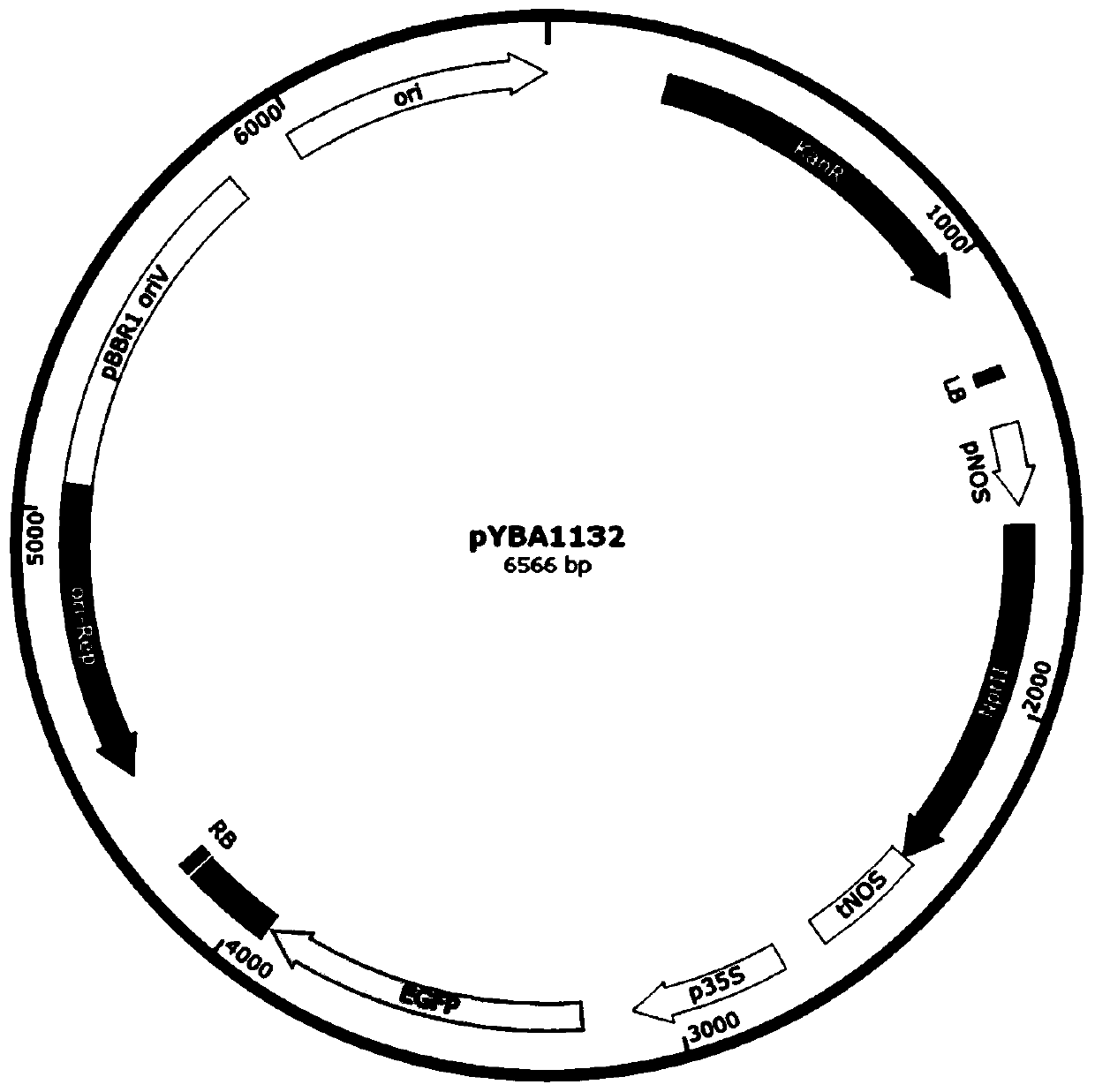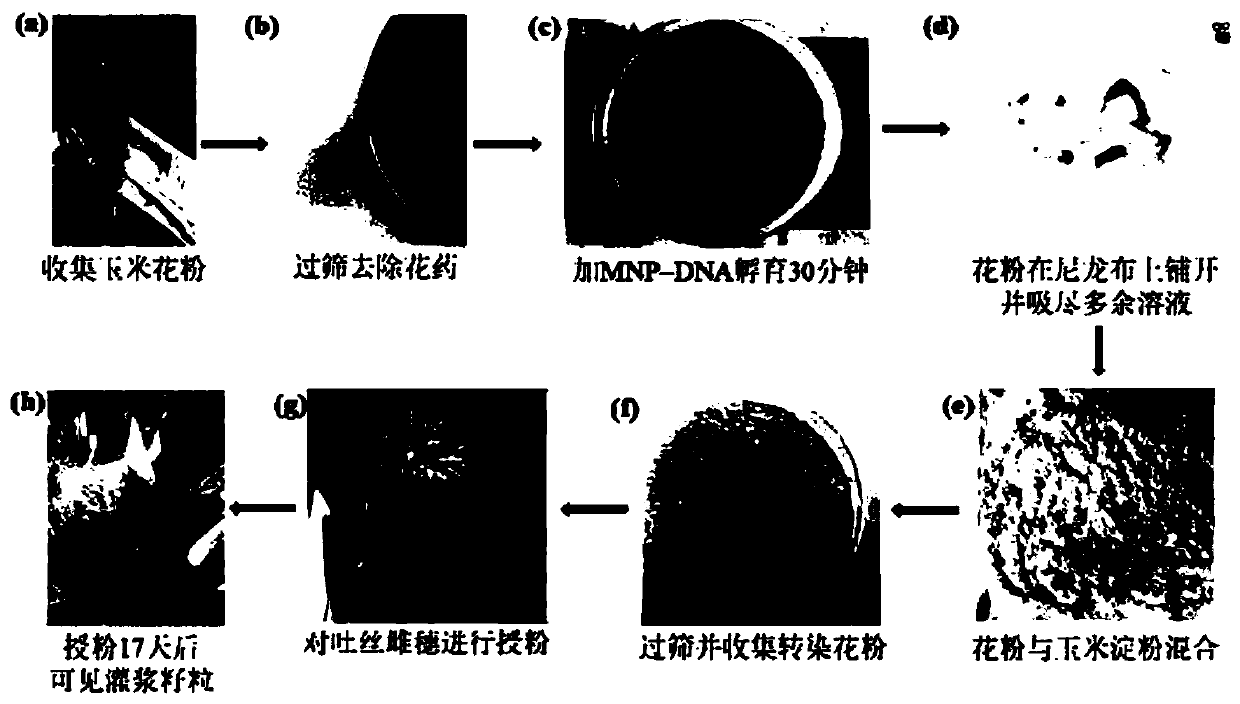DNA introduction method independent of corn genotype
A genotype and maize technology, applied in the field of plant genetic engineering, can solve the problems of difficulty in meeting the needs of molecular breeding in the maize seed industry, low tissue culture efficiency of commercial varieties, and dependence, etc. The effect of efficient import
- Summary
- Abstract
- Description
- Claims
- Application Information
AI Technical Summary
Problems solved by technology
Method used
Image
Examples
Embodiment 1
[0037]A method of DNA introduction independent of maize genotype:
[0038] Positively charged Fe modified with polyethyleneimine (PEI) 3 o 4 Magnetic nanoparticles (MNPs, Cat. No. 9006, Chemicell, Germany) are used as gene carriers to bind and protect negatively charged DNA. Under the action of a magnetic field, the nano-magnetic beads transfer DNA to corn pollen through the pollen pores, and through the natural reproductive process of pollination and fruiting, the introduction of the target gene is realized.
[0039] The corn materials used are backbone inbred lines: 178, B73, HZ178, Jing 92 and Zheng 58.
[0040] The vector used is the expression vector pYBA1132 containing green fluorescent protein (Liu et al., PlantGenomics in China XIV, 2013, 169) constructed by the unit, and the sequence of the pYBA1132 vector is shown in SEQ ID NO.1, including the CaMV shown in SEQ ID NO.2 The 35S promoter (p35S) and the enhanced green fluorescent protein gene EGFP (Enhance green fluo...
Embodiment 2
[0051] Fluorescent tracking of the entire import process (taking Beijing 92 as an example)
[0052] 1) Expression of EGFP gene in maize pollen. An appropriate amount of transfected pollen was dipped and inoculated on a corn pollen solid medium (15 g / L agar powder was added to the corn pollen culture solution), and cultured at 25° C. in the dark for 24 hours. Dip an appropriate amount of cultivated corn with a brush, gently disperse it in the corn pollen culture solution, and observe the green fluorescence with 488nm excitation light under a laser confocal microscope. Fluorescence observation results such as image 3 shown. image 3 Middle, MNP+EGFP: maize pollen magnetically transfected with EGFP gene; MNP: maize pollen treated with magnetic beads only; CK: non-transfected maize pollen; Merge: green fluorescence and bright field overlay; GFP: green fluorescence; Bright : bright field. according to image 3 It can be seen that 92% (491 / 536) of the pollen transfected with t...
Embodiment 3
[0056] Molecular detection of plants transfected with EGFP Jing92T1
[0057] At the three-leaf stage, the young leaves of Jing 92T1 generation plants transfected with EGFP were taken to extract genomic DNA, total RNA and total protein. Perform PCR detection with the primers in Table 2, and then perform RT-PCR detection on PCR positive plants. In table 1: EGFP-F is the upstream primer (20bp) that is used to detect EGFP gene, and sequence is as shown in SEQ ID No.4; EGFP-R is the downstream primer (20bp) that is used to detect EGFP gene, and sequence is as shown in SEQ ID Shown in No.5; ZmActin1-F is the upstream primer (22bp) that is used to detect ZmActin1 internal reference gene, and sequence is as shown in SEQ ID No.6; ZmActin1-R is the downstream primer (20bp) that is used to detect ZmActin1 internal reference gene, The sequence is shown in SEQ ID No.7. Subsequently, the RT-PCR positive plants were analyzed by Western blot.
[0058] Image 6 It is the graph of molecular...
PUM
| Property | Measurement | Unit |
|---|---|---|
| diameter | aaaaa | aaaaa |
| diameter | aaaaa | aaaaa |
Abstract
Description
Claims
Application Information
 Login to View More
Login to View More - Generate Ideas
- Intellectual Property
- Life Sciences
- Materials
- Tech Scout
- Unparalleled Data Quality
- Higher Quality Content
- 60% Fewer Hallucinations
Browse by: Latest US Patents, China's latest patents, Technical Efficacy Thesaurus, Application Domain, Technology Topic, Popular Technical Reports.
© 2025 PatSnap. All rights reserved.Legal|Privacy policy|Modern Slavery Act Transparency Statement|Sitemap|About US| Contact US: help@patsnap.com



